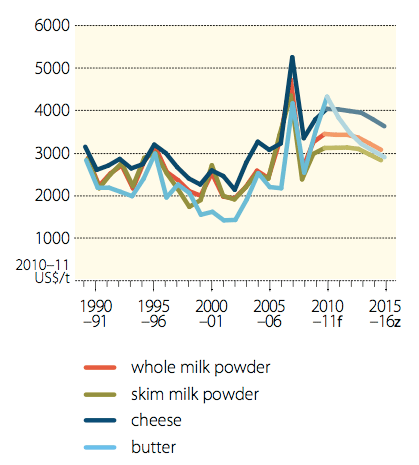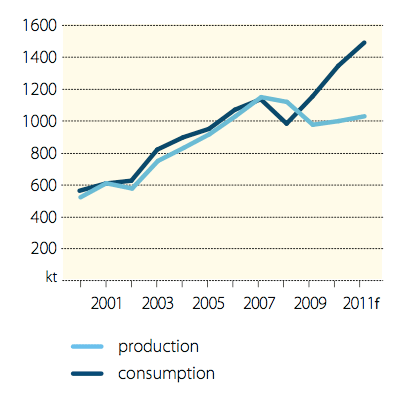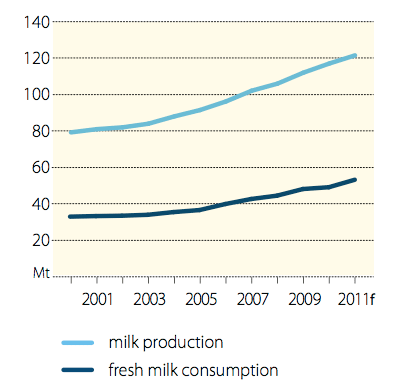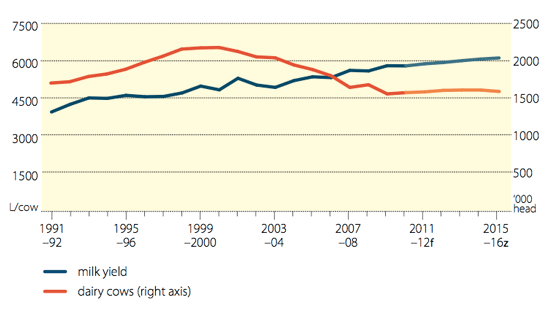



Australian Dairy Outlook
World dairy product prices were supported in the first half of 2010–11 by strong import demand, particularly from the Russian Federation and China, writes David Barrett in the ABARE dairy outlook 2011-2015.
Outlook to 2015–16
Although European Union and United States milk production increased in the second half of 2010, production in New Zealand and Australia was constrained by adverse weather conditions over the same period.
World Dairy Prices

World prices for most dairy products are forecast to remain firm through 2011–12. The forecast strong market is expected to reflect sustained import demand, particularly from China, the Russian Federation, the Middle East and developing Asia, and limited milk production increases in key exporting countries.
Medium-term outlook for world dairy pricesThe demand for dairy products is expected to continue to grow over the medium term in line with further expected increases in consumer incomes in developing countries. However, toward the end of the outlook period, increases in world export supplies are expected to outpace the growth in import demand, resulting in world dairy prices falling in real terms. Nevertheless, world dairy products prices are projected to average around 30–40 per cent higher, in real terms, over the outlook period compared with the average prices over the five years to 2006–07.
World dairy product supplies to increase
Global milk production is forecast to rise in 2011–12 as production expands in most of the major producing countries, particularly those in Asia, Europe and North America. However, forecast relatively high feed grain prices are likely to constrain growth in milk production, at least in the short term.
The expansion in EU milk production, which began in the 2010–11 marketing year (April to March) as a result of higher farmgate prices, is expected to continue in 2011–12. Most of the increase in milk production is expected in Germany, France, the Netherlands and the United Kingdom and is likely to be used for cheese manufacturing to meet export demand.
US milk output is forecast to increase by 1.8 per cent in 2011 to a record 88.9 million tonnes. Although milk prices in 2011 are forecast to remain close to the relatively high average prices in 2010, forecast higher feed costs are expected to constrain the increase in milk output by dampening the incentive of high prices to expand cow numbers and milk yields.
Adverse seasonal conditions constrained the growth in New Zealand milk production in 2010–11, but production is forecast to increase by around 2–3 per cent in 2011–12 in response to continuing relatively high farmgate milk prices. The New Zealand dairy herd is forecast to increase by 2 per cent to around 4.8 million head by 30 June 2011.
Milk Production

Over the medium term, global milk production is forecast to increase in the traditional dairy exporting countries as well as in the emerging countries of South America and Asia, particularly China and India.
In the European Union, milk production is projected to increase through to 2014–15 but to remain below quota. Quotas are due to be removed on 1 April 2015. The EU milk quota is set to rise by 1 per cent each marketing year through to 2015–16. In 2009–10, milk production in the European Union was around 7 per cent below the overall milk quota.
While EU farmgate prices for milk are expected to remain favourable over the next two to three years, a number of factors are likely to constrain the growth in EU milk output. Feed grain prices are projected to remain relatively high over this period, which is expected to increase the costs of intensive dairy farm operations. Furthermore, ongoing costs associated with meeting environmental regulations are likely to add to dairy farmers’ costs of production. Over the medium term, milk production is forecast to rise in the Netherlands, Germany and France but continue to decline in Romania and Bulgaria, where dairying costs are higher.
As shown in 2010, the US dairy industry has the capacity to respond relatively quickly to favourable economic signals by increasing milk production. Over the medium term, US milk production is forecast to increase further as a result of projected favourable milk prices. However, similar to the situation in the European Union, expected continuing high feed grain prices over the next couple of years are likely to constrain the growth in US production. The prospect of lower feed grain prices in the second half of the outlook period is expected to improve dairying profitability, leading to stronger gains in milk production.
Given the relatively favourable price outlook, New Zealand milk production is projected to increase by around 2 per cent a year over the medium term. While milk yields are projected to rise over this period, there are also expected to be further conversions of beef and sheep farms to dairying in the South Island, which reflects the higher profitability of dairying compared with beef and sheep meat production. Most of the recent expansion in the national dairy herd has occurred in the South Island, which now accounts for around one-third of New Zealand’s dairy herd. It is expected that the increased New Zealand milk production will be exported as dairy products such as whole milk powder, given the limited opportunities for expanding sales in its domestic market.
Milk production in Brazil is expected to increase over the medium term, as there is considerable scope to further increase productivity in the dairy sector. It is expected that nearly all the growth in Brazilian milk production will be used to satisfy a forecast rise in domestic demand. As a result, Brazil is expected to remain a small exporter of milk powders and condensed milk over the medium term. Following recent investments in Argentina’s dairy industry, milk production in that country is projected to continue to rise in the medium term. Higher milk production is expected to result in increased Argentine exports of milk powders. In 2011, Argentina’s exports of whole milk powder are forecast to rise by 18 per cent to around 200 000 tonnes.
Global trade in dairy products to grow
Over the medium term continuing economic growth in the major dairy importing regions is expected to underpin demand and lead to increased trade in dairy products. In particular, increased import demand for dairy products is expected in the developing countries of Asia, North Africa and the Middle East. The rise in demand is expected to be driven by growth in per person incomes and an increase in the share of dairy products in diets. With limited scope to significantly increase domestic production in most developing countries, much of the expected increase in dairy product demand is likely to be met through higher imports.
Chinese import demand underpins global dairy tradeChinese imports of whole milk powder have increased significantly since 2009 and are forecast to reach around 400 000 tonnes in 2011, around 25 per cent of global trade. Chinese imports of skim milk powder have also risen and are forecast to reach 100 000 tonnes in 2011. The increase in China’s imports of milk powders reflects a sharp fall in Chinese milk production and consumers’ concerns about the safety of domestically produced product following the melamine scare in 2008.
Whole milk powder production and consumption in China

While the consumption of milk and dairy products in China has risen dramatically over the past 15 years, there is potential for further strong gains in consumption in China over the medium term and beyond. China’s consumption of dairy products is still relatively low compared with consumption in other developed Asian countries, such as the Republic of Korea and Japan. Per person consumption of milk in Chinese urban areas was 14.91 kilograms in 2009 compared with 4.62 kilograms in 1995. Per person consumption of milk and processed dairy products is much lower in rural areas at 3.6 kilograms in 2009, although it had increased from an average of 0.6 kilograms in 1995.
Factors behind the recent growth in Chinese consumption of dairy products include higher disposable incomes, increasing health consciousness among the growing middle class and expanding retail outlets.
Although the growth in milk production in China was significant for much of the past decade, it has slowed considerably following the melamine scare in 2008. Nevertheless, China has the potential to further expand production over the medium term by increasing cow numbers and herd productivity. Despite this growth potential, it is unlikely that growth in domestic demand for milk and dairy products can be met by domestic production over the short to medium term. Over the outlook period, China will continue to import significant quantities of milk powders. Given the size of the Chinese import market for milk powders, this development is likely to provide considerable support for world dairy product prices.
Cheese production and consumption in the Russian Federation

The Russian Federation is a large global importer of butter, cheese and milk powders. Imports of cheese by the Russian Federation increased by 20 per cent in 2010 to 365 000 tonnes while milk powders rose by 70 per cent to 240 000 tonnes, reflecting firm demand and lower domestic production. In 2010 milk production was adversely affected by a severe drought which resulted in farmers culling herds as domestic feed supplies in the Russian Federation were reduced considerably.
While dairy cow numbers in the Russian Federation are forecast to decline further in 2011, the national herd is expected to increase over the medium term. In recent years the Russian government has introduced policies such as subsidised credit for the construction of new dairies to increase milk production.
Per person consumption of cheese in the Russian Federation is well below many Western European countries, and further growth in per person incomes is projected to lead to a rise in per person consumption of cheese over the medium term. Overall, the volume of dairy product imports in the Russian Federation is expected to remain largely unchanged over the next few years and could even contract slightly as domestic milk production recovers from the drought of 2010.
Milk production and consumption in India

Traditionally India has been self-sufficient in milk and dairy products, exporting small quantities of butter, skim milk powder and casein since the early 2000s. Relatively high import tariffs on a range of dairy products have protected the domestic dairy industry. However, domestic supply did not keep pace with demand in 2009 and this led to the import of 22000 tonnes of butter and butter oil. In 2010, with slow growth in milk production, the government allowed the duty-free import of up to 30000 tonnes of milk powder and 15 000 tonnes of butterfat.
Over the medium term the consumption of milk and dairy products in India is expected to grow strongly in response to population growth, higher household incomes and a strong preference for liquid milk as a protein source. The preference for liquid milk reflects its cultural significance as well as the tradition of vegetarianism. Despite higher milk prices in recent years, per person consumption of milk in India has continued to increase.
To maintain self-sufficiency in dairy products, milk production in India will need to keep pace with the growth in Indian demand for milk and dairy products. Indian milk production has been increasing by around 4 per cent a year since 2000 and is forecast to reach 121.5 million tonnes in 2011. While Indian milk yields are well below those achieved in the developed economies, production costs are very low with animal feeding relying on crop residues. In 2010, the Indian government developed a national dairy plan by which it intends to double the country’s milk production by 2020. Such an outcome will depend on increasing milk productivity through the import of animal genetics to improve the dairy herd as well as improving feed quality. Overall, it is expected that India will remain largely self-sufficient in milk and dairy products over the medium term.
Prospects for key dairy products
Cheese market Japan and the Russian Federation, which accounted for nearly 40 per cent of global cheese imports in 2010, are expected to remain the dominant importers of cheese over the medium term. In contrast, US cheese imports are expected to decline as a result of forecast higher domestic production and a relatively weak US dollar. The demand for cheese in the Republic of Korea, Mexico, South-East Asia, the Middle East and North Africa is expected to increase in response to higher disposable incomes and changing dietary patterns that include a greater share of livestock products.
Japanese imports of cheese are forecast to rise slightly to around 210000 tonnes in 2011. In 2010, Australian and New Zealand cheese exports to Japan faced increased competition from US exports following depreciation of the US dollar relative to the Australian and New Zealand currencies.
Over the medium term, although domestic milk production in Japan is forecast to decline, an anticipated fall in fresh milk consumption is likely to result in more milk being diverted to the production of processed dairy products, such as cheese. Consequently, the prospect of higher domestic cheese production is expected to constrain the growth in Japanese cheese imports over the projection period.
Imports of cheese by the Republic of Korea are forecast to increase by 10 per cent to around 64000 tonnes in 2011, reflecting continuing strong growth in domestic demand. Further growth in Korean consumption of cheese is expected over the medium term as consumers increasingly adapt to Western style foods, such as pizza and pastas.
World cheese prices are forecast to increase by around 1 per cent to US$4100 a tonne in 2011–12, following an expected rise of 8 per cent in 2010–11. Over the medium term, world cheese prices are projected to fall slightly in real terms until 2013–14, then decline more sharply to US$3632 a tonne (in 2010–11 US dollars) toward the end of the projection period.
World butter prices are forecast to decline by 10 per cent in 2011–12 to US$3900 a tonne, following an expected increase of 24 per cent in 2010–11. Manufacturers are expected to increase butter production in response to relatively higher butter prices compared with other dairy products. If higher prices persist for a prolonged period, the end users, especially in the food processing sector, are expected to reduce their demand by reducing the butter fat content or substituting cheaper alternatives, such as vegetable oils, in their food products, placing downward pressure on prices.
Over the medium term world butter prices are projected to decline, in real terms, reaching US$2905 a tonne by 2015–16, partly reflecting higher supplies in the major exporting countries.
Global trade in milk powders is expected to be underpinned by growing import demand from China, South East Asia and the emerging economies of the Middle East and North Africa.
New Zealand and the European Union are the dominant exporters of whole milk powder, with smaller volumes being supplied from Argentina and Australia. Most of the projected increase in import demand for whole milk powder is expected to be met by a further expansion in New Zealand exports. In recent years manufacturing milk in the European Union has been diverted from whole milk powder production to cheese production. It is likely that this trend will continue over the next two to three years. These developments are expected to provide strong support to milk powder prices over the medium term.
World whole milk powder prices are forecast to remain relatively high over the next three years. Increased milk supplies in the major exporting countries toward the end of the projection period are expected to lead to lower real prices by 2015–16.
South-East Asia is an important market for Australian milk powder exports but Australian exporters are expected to face increased competition from the United States over the medium term. In the two years to 2010, the United States increased its exports of skim milk powder to 152 000 tonnes a year. The South-East Asian market now accounts for around 40 per cent of US exports of milk powder.
World skim milk powder prices are forecast to rise in real terms over the next three years. Toward the end of the outlook period, however, increased world exports, particular from the United States and New Zealand, are expected to lead to downward pressure on prices. While EU intervention stocks of skim milk powder were around 195 000 tonnes at the end of 2010, a large share of these stocks will be distributed within the European Union by charitable organisations to persons in need.
Prospects for the Australian dairy industry
While world dairy product prices are forecast to increase slightly in 2011–12, returns to Australian dairy exporters are expected to be offset, to some extent, by an assumed high Australian dollar.
The Australian average farmgate price for milk is forecast to average 38.8 cents a litre in 2011–12, around 1 per cent higher than the forecast average farmgate milk price in 2010–11. Farmgate prices for milk are projected to fall slightly over the outlook period and to reach 34.7 cents per litre (in 2010–11 dollars) in 2015–16, reflecting weaker international dairy prices towards the end of the outlook period.
Although some dairying regions in Australia were affected by floods in early 2011, the overall impact on national milk production was minimal. Australian milk production is forecast to increase by 1 per cent to 9.11 billion litres in 2010–11, before rising again by 2.1 per cent to 9.30 billion litres in 2011–12. The forecast increases mainly reflect the effect of improved water availability in the main dairying regions.
Over the medium term, milk production is projected to rise gradually to reach a peak of 9.75 billion litres in 2014–15, driven largely by productivity increases.
Over the 10 years to 2009–10, annual milk yields in Australia increased by 20 per cent to reach 5810 litres a cow. The rise in yields has been driven by improved herd genetics as well as advances in pasture management and increased feeding of grains and forage crops. It is expected that these trends will continue over the medium term, with milk yields projected to reach 6120 litres a cow by 2015–16.
Australian dairy cow numbers are projected to rise slightly over the outlook period to reach 1.61 million head by 2013–14, reflecting favourable returns to dairying and an assumption of improved seasonal conditions and availability of irrigation water.
Australian dairy cows and milk yield

Australian milk production and price

Over the 10 year period to 2009–10, reduced water availability for irrigation farms in northern Victoria and southern New South Wales led dairy farmers in these regions to reduce their cow herds and adopt management strategies to cope with the variable seasonal conditions.
Given the increase in water levels in the main irrigation dams during 2010 and early 2011, and assuming favourable seasonal conditions, water allocations for irrigation are likely to be well above those of recent years for at least the next two to three years. Consequently, dairy farmers in the irrigation areas of northern Victoria and southern New South Wales are likely to rely less on purchased feeds. Nevertheless, variability in seasonal conditions will continue to be a key issue for the Australian dairy industry over the medium to longer term.
The value of Australian dairy exports is forecast to decrease by 1 per cent to $2.2 billion in 2011–12, following a forecast rise of 8 per cent in 2010–11. Over the medium term the value of Australian dairy exports is projected to be around $2.0 billion (in 2010–11 dollars) in 2015–16, reflecting relatively lower projected world dairy product prices toward the end of the outlook period.
While Australian dairy manufacturers are expected to increase production of whole milk powder over the next few years in response to relatively strong export demand, cheese is expected to remain the predominant dairy product produced and exported. In recent years there has been a trend away from the production of cheddar cheeses to non-cheddar cheese types, reflecting changing demand in both domestic and export markets.
| TheCattleSite News Desk |


